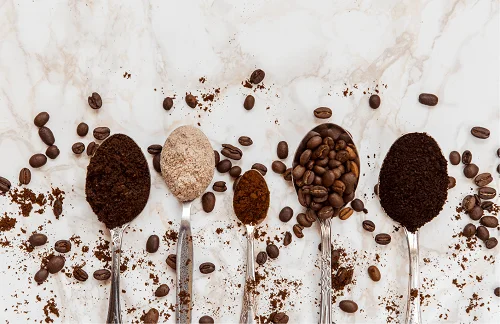Coffee
The Basics of Coffee Grind Size
The Basics of Coffee Grind Size
Grind size is an essential factor in making a perfect cup of coffee. It plays a crucial role in determining the taste, aroma, and strength of your coffee. Understanding the basics of coffee grind size is essential for achieving your desired coffee flavor and brewing method.
Choosing the right coffee grind size can be a challenging task, especially if you are new to coffee brewing. There are various types of coffee grinds, and each one has its ideal brewing method and flavor profile.
In this blog, we will discuss the importance of grind size in coffee brewing and provide an overview of the different types of coffee grinds. Understanding these basics will help you make informed decisions and achieve the perfect coffee grind for your preferred brewing method.
Why Does Grind Size Matter?
Grind size is an essential factor that affects the taste, aroma, and strength of your coffee. The size of the coffee grind determines the rate of extraction, which ultimately affects the overall coffee flavor. Here’s how grind size affects the coffee brewing process:
- Flavor: The grind size impacts the surface area of the coffee that is exposed to water. A finer grind exposes more surface area, leading to a more robust coffee flavor, while a coarser grind leads to a milder flavor.
- Aroma: The aroma of coffee is a crucial element that affects your overall coffee experience. A finer grind size releases more aroma, while a coarser grind size produces a milder aroma.
- Strength: The strength of coffee refers to its concentration level, which depends on the extraction rate. A finer grind size leads to a stronger coffee due to a higher extraction rate, while a coarser grind size results in a weaker coffee.
Different brewing methods require different grind sizes to achieve optimal flavor and strength. Here are some examples:
- French Press: A coarse grind is ideal for French press brewing because the coffee grounds are in contact with the water for an extended period.
- Pour Over: A medium-fine grind is recommended for pour-over brewing to produce a balanced flavor profile.
- Espresso: A fine grind is essential for espresso brewing because the coffee is in contact with water for a shorter time, requiring a finer grind to extract the flavor and strength.
Overall, grind size is a critical factor in coffee brewing, affecting the flavor, aroma, and strength of your coffee. Understanding the impact of grind size can help you achieve the perfect coffee taste and experience.
Types of Coffee Grinds
There are four main types of coffee grinds, each with its unique characteristics that affect the brewing process and coffee flavor.
- Coarse Grind: Coarse grind coffee has a granular texture and is ideal for brewing methods that require a longer contact time between water and coffee, such as French press or cold brew. The large size of the coffee grounds allows for a slower extraction, resulting in a milder coffee flavor.
- Medium Grind: Medium grind coffee has a sand-like texture and is best suited for pour-over, drip coffee makers, and some espresso machines. The medium grind allows for a balanced extraction, resulting in a well-rounded coffee flavor.
- Fine Grind: Fine grind coffee has a powdery texture and is perfect for espresso machines, Turkish coffee, and some pour-over methods. The fine grind allows for a quicker extraction, resulting in a stronger coffee flavor.
- Extra Fine Grind: Extra fine grind coffee has an ultra-fine powdery texture and is best suited for Turkish coffee or espresso machines that require a high-pressure extraction. The extra fine grind allows for the quickest extraction, resulting in the most potent coffee flavor.
It’s worth noting that each coffee brewing method has its ideal grind size, and using the wrong grind size can result in an unsatisfactory coffee experience.
In summary, understanding the different types of coffee grinds and their uses can help you choose the best coffee grind for your preferred brewing method and achieve the desired coffee flavor and strength.
Choosing the Right Grind Size
Now that we’ve covered the different types of coffee grinds let’s explore how to choose the right grind size for your preferred brewing method.
- Determine Your Brewing Method: Different brewing methods require different grind sizes. For example, French press and cold brew require coarse grinds, while espresso and Turkish coffee require extra-fine grinds. Therefore, the first step in choosing the right grind size is to determine the brewing method you’ll be using.
- Experiment with Grind Sizes: Once you’ve identified your preferred brewing method, it’s time to experiment with different grind sizes. Start with the recommended grind size for your brewing method and adjust accordingly until you achieve the desired coffee flavor and strength.
- Consider the Extraction Time: The extraction time or the amount of time coffee and water are in contact, is also essential in determining the right grind size. A longer extraction time requires a coarser grind, while a shorter extraction time requires a finer grind.
- Invest in a Coffee Grinder: To achieve consistent grind sizes, invest in a quality coffee grinder that allows you to adjust the grind settings. Blade grinders are less expensive but produce inconsistent grind size, while burr grinders offer more precision and consistency.
Summary
In summary, choosing the right grind size is crucial in achieving the desired coffee flavor and strength. Experiment with different grind sizes, consider the extraction time and invest in a quality coffee grinder to achieve consistency. Grind size plays a critical role in coffee brewing. The right grind size will affect the flavor, aroma, and strength of your coffee, and different brewing methods require different grind sizes. Therefore, it’s essential to identify your preferred brewing method and experiment with different grind sizes until you achieve the desired coffee flavor and strength.
Investing in a quality coffee grinder that allows you to adjust the grind settings is also crucial in achieving consistent grind size. While blade grinders are less expensive, they produce inconsistent grind sizes, while burr grinders offer more precision and consistency.
In conclusion, achieving the perfect coffee grind requires patience, experimentation, and the right tools. By following the tips outlined in this article, you’ll be well on your way to brewing the best coffee possible.

